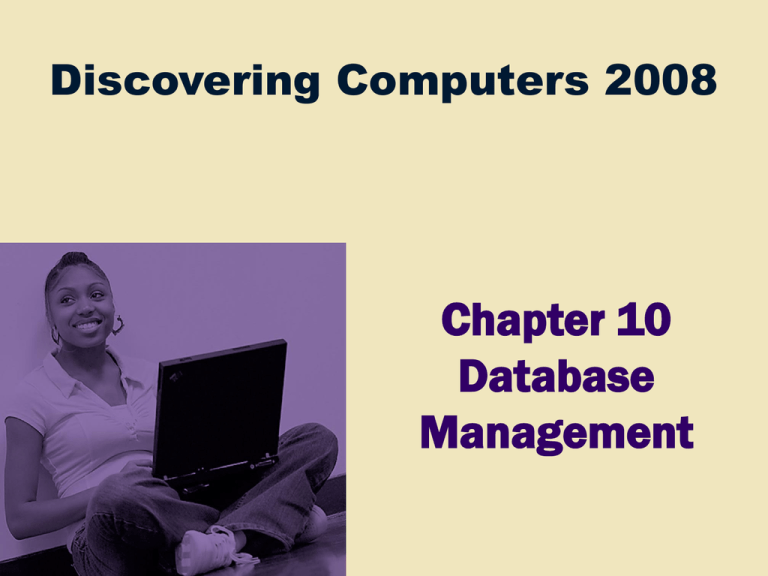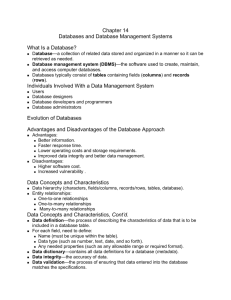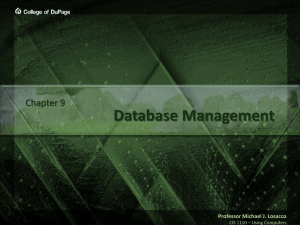Chapter 10 Database Management Discovering Computers 2008
advertisement

Discovering Computers 2008 Chapter 10 Database Management “If you want to leave footprints in the sands of time, don’t drag your feet.” Data vs. Information Data - raw facts Information - processed data Data integrity- accuracy of data Data security - protecting data Data and Information What is data integrity? Degree to which data is correct Garbage in, garbage out (GIGO)—computer phrase that means you cannot create correct information from incorrect data Garbage in Garbage out Data integrity is lost p. 516 Next Data and Information What are the qualities of valuable information? Accurate Verifiable Timely Organized Accessible Useful Cost-effective p. 516 - 517 Next Hierarchy of Data Bit - one binary digit Byte - eight bits Field - one or more characters (name, ssno) Record - collection of related fields File - collection of related records Database - collection of related files Maintaining Data What is file maintenance? Procedures that keep data current Adding records Changing records Deleting records p. 520 Next Maintaining Data What is validation? Process of comparing data with a set of rules to find out if data is correct Reduce data entry errors and enhance data integrity before program writes data on disk p. 522 - 523 Fig. 10-8 Next File processing vs. databases File processing system (flat files) data redundancy isolated data File Processing Versus Databases What is the database approach? Many programs and users can share data in database Secures data so only authorized users can access certain data p. 524 - 525 Fig. 10-9 Next File Processing Versus Databases What are the strengths of the database approach? Reduced data redundancy Improved data integrity Shared data Easier access p. 525 Reduced development time Next DBMS Data Base Management System (DBMS) set of programs designed to control access to the database and manage the data Data dictionary Data maintenance and retrieval - query language Data security Backup and recovery Database Management Systems What are popular database management systems (DBMSs)? p. 526 Fig. 10-11 Next Database Management Systems What is a data dictionary? Contains data about each file in database and each field within those files p. 527 Fig. 10-12 Next Database Management Systems What is a query? Request for specific data from a database Query language consists of simple, English-like statements that allow users to specify data to display, print, or store p. 528 - 529 Fig. 10-13 Next Database Management Systems Data security Access privileges define activities that specific user or group of users can perform DBMS provides means to ensure only authorized users can access data Read-only privileges user can view data, but cannot change it p. 530 - 531 Full-update privileges user can view and change data Next Types of Databases Relational database - links files through the use of a common field Object-oriented database - database based on an object-oriented model. Can store more types of data and access it faster (photos, video clips) Databases cont. Hierarchial database - (tree structure) - organized like a family tree - each parent can have more than one child, but each child may have only one parent Network database - Like an hierarchial database except that each child may have more than one parent Multidimensional Database – Stores data in dimensions (can store more than two dimensions – ex. Storing text and video clips) Relational, Object-Oriented, and Multidimensional Databases What is a relational database? Stores data in tables that consist of rows and columns Each row has primary key Each column has unique name Stores data relationships Uses specialized terminology p. 533 Fig. 10-19 Next Relational, Object-Oriented, and Multidimensional Databases What is Structured Query Language (SQL)? Allows you to manage, update, and retrieve data Has special keywords and rules included in SQL statements p. 534 Fig. 10-21 Next Relational, Object-Oriented, and Multidimensional Databases What is an object-oriented database (OODB)? Stores data in objects Advantages Object is item that contains data, as well as actions that read or process data Can store more types of data Can access data faster Programmers can reuse objects Often uses object query language (OQL) p. 534 - 535 Next Relational, Object-Oriented, and Multidimensional Databases What are examples of applications appropriate for an object-oriented database? Multimedia databases Store images, audio clips, and/or video clips Computer-aided design (CAD) databases Store data about engineering, architectural, and scientific designs Hypermedia databases Contain text, graphics, video, and sound p. 534 Groupware databases Store documents such as schedules, calendars, manuals, memos, and reports Hypertext databases Contain text links to other documents Web databases Link to e-form on Web page Next Relational, Object-Oriented, and Multidimensional Databases What is a multidimensional database? Stores data in dimensions Multiple dimensions, also called hypercube, allow users to analyze any view of data Can consolidate data much faster than relational database p. 535 Next Relational, Object-Oriented, and Multidimensional Databases What is a data warehouse? Huge database system that stores and manages data required to analyze historical and current transactions Quick and efficient way to access large amounts of data Uses multidimensional databases p. 536 Often uses a process called data mining to find patterns and relationships among data Data mart is smaller version of data warehouse Next Web Databases What is a Web database? Database you access through the Web by filling in a form on a Web page Usually resides on a database server, a computer that stores and provides access to a database p. 536 - 537 Fig. 10-23 Next Database Administration What is the role of the database analyst and administrator? Database analyst (DA) Focuses on meaning and usage of data Decides proper placement of fields, defines relationships, and identifies users’ access privileges p. 538 Database administrator (DBA) Creates and maintains data dictionary, manages database security, monitors database performance, and checks backup and recovery procedures Next Discovering Computers 2008 Chapter 10 Database Management






